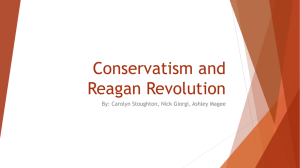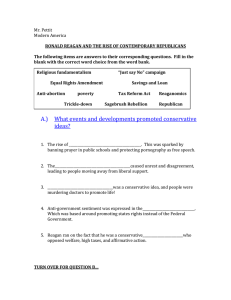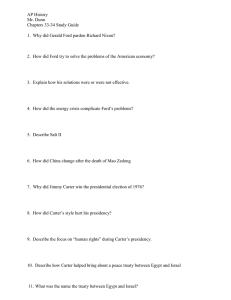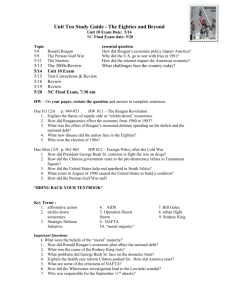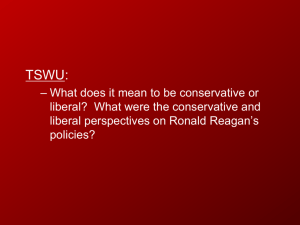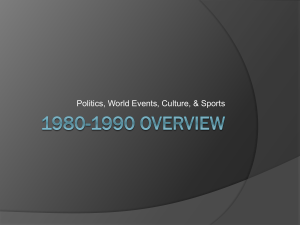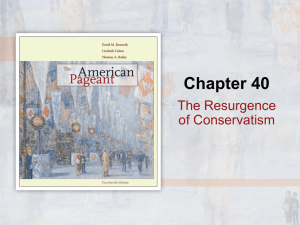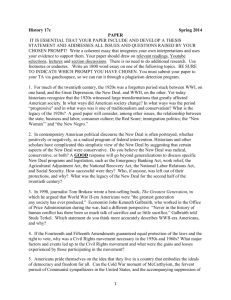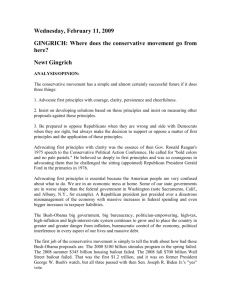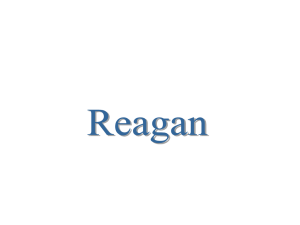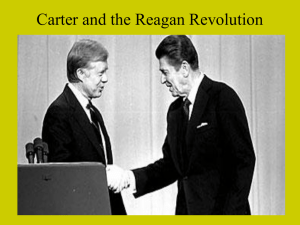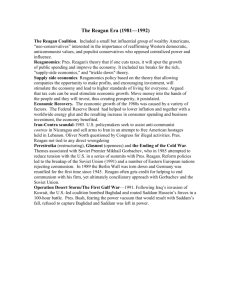Ronald Reagan - Boone County Schools
advertisement
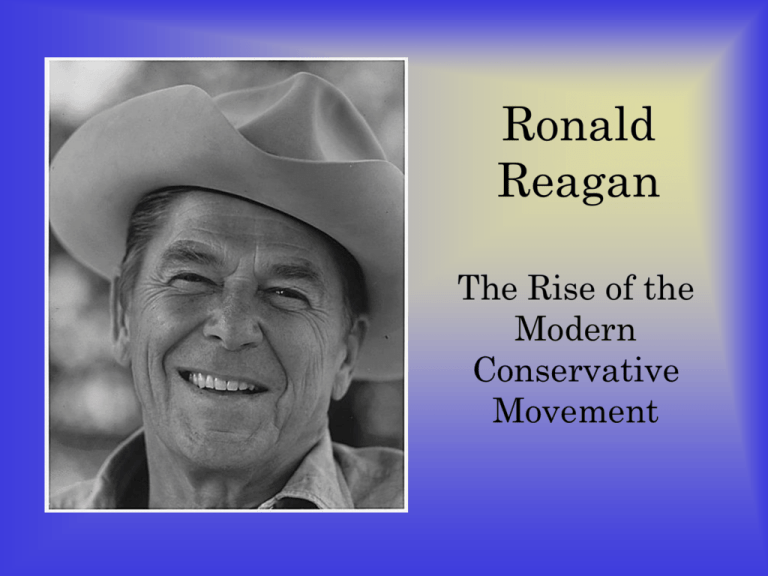
Ronald Reagan The Rise of the Modern Conservative Movement Ronald Reagan • Born in Illinois, 1911 • Lifeguard, Radio Announcer • Launched an acting career during the Great Depression • Became conservative during socialist and communist threats in the movie industry (HUAC) • Switched from Democratic to Republican Party in the late 50s/early 60s The 1980 Election • Between current President Jimmy Carter (Democrat) and Republican Ronald Reagan The New Conservative Coalition The NEW RIGHT – Conservative evangelical Christians • To restore Christian Values in America – Southern Democrats – Reduction of Social Programs – Called for reduction in size and power of government – Favored return of US military pride – Patriotic focus The 1980 “Revolution” • Carter’s perceived mishandling of major challenges • Reagan’s ability to communicate “The Great Communicator” • Few simple wellarticulated idea Map 30.4 Presidential Election of 1980 (p. 903) Assassination Attempt • John Hickley Jr. – assassin – Wanted to win Jodie Foster’s heart • Three people shot, including Reagan • Just 69 days into first presidency • Reagan recovered to shot in lung • James Brady, Press Secretary suffered a head shot and was disabled. Supply-Side Economics a.k.a “Reaganomics” • Cut taxes to put more money into the hands of businesses • Cut taxes on the wealthiest Americans • Lower taxes = more investment in the “supply side” of the economy • Would: – promote and create new jobs – encourage capital investment, and – lead to stimulated industrial growth ECONOMIC THEORIES • Supply Side Economics (generally favored by conservatives): – Tax breaks to the wealthy capital accumulation higher productivity lower prices job creation higher tax revenues collected by the government money to reduce federal budget deficits. • Demand Side or Keynesian Economics (generally favored by liberals): – tax breaks to working/middle classes higher productivity job creation higher tax revenues collected by the government money to reduce federal budget deficits. Cutting Government Regulation - “deregulation” • Continued Carter’s programs to deregulate key industries • Energy, Transportation and Banking Industries • Challenged Air Traffic Controllers in 1981 Fired those who refused to go back to work after a strike. Slowed Federal Growth - New Federalism (Reagan-style) • Limiting government – Eliminated public service jobs – reduced unemployment compensation – lowered welfare benefits – raised fees for Medicare patients • Federal domestic spending still grew for a couple of years Reagan and Military Buildup • Sharp increase in military spending = buildup • New weapons and new technology • Neoconservatives (Neocons = Dick Cheney, Don Rumsfeld, Paul Wolfowitz, Condoleeza Rice, Richard Armistead, Colin Powell, etc.) • Strategic Defense Initiative (SDI) = better known as Star Wars Reagan and the Cold War • Called Soviet Union the “evil empire” • Reagan - Cold Warrior – Lebanon – Libya – Grenada – El Salvador – Nicaragua (Contra rebels supported by US) Reagan: Economic Recession, and Recovery • 1981-1982 Recession • Inflation slowed, consumer spending increased • Stock market grew • Federal deficit grew even as domestic spending decreased • National debt = $909 billion in 1980 --$3.2 trillion in 1990 Election of 1984 • Patriotic Renewal • 59% of popular vote • Second largest electoral victory in history • 1984 Olympics in Los Angeles • Communist-bloc countries boycotted • 1986 - 100th anniversary of Statue of Liberty • 1987 - 200th anniversary of the Constitution Other issues 1984-1988 • AIDS Awareness • Women’s Movement stalled (ERA failed in 1982) • Supreme Court conservatives – Sandra Day O’Connor – Anthony Kennedy – Antonin Scalia – Chief Justice William Rehnquist More issues: 1984-1988 • Farm Crisis - foreclosures • Manufacturing shift - from metal and textiles (overseas = outsourcing due to labor costs) • Service sectors continued to grow • Wealthiest Americans flourished in the 1980s • Jan 28, 1986 - Space Shuttle Challenger exploded shortly after take off Cold War Continued • Afghanistan – Soviet republic – In 1970s Afghans tried to fight Soviets for independence • 1980s • USA convinces Saudi Arabia to send troops “mujahadeen” (holy warriors) to fight against Soviets • One of the mujahadeen is Bin Laden IRAN-CONTRA What was it? Sale of weapons to Iran to ransom US hostages held in Lebanon and to finance anticommunist contra-revolucionarios (contras) in Nicaragua in order to depose the Sandanistas Illegal because Congress had limited amount of aid US could provide (Boland Amendment) US sold arms to Iran Illegal because he could not sell arms to a “terrorist state” without Congressional approval Administration response: lied to the press and Congress, withheld crucial documents
